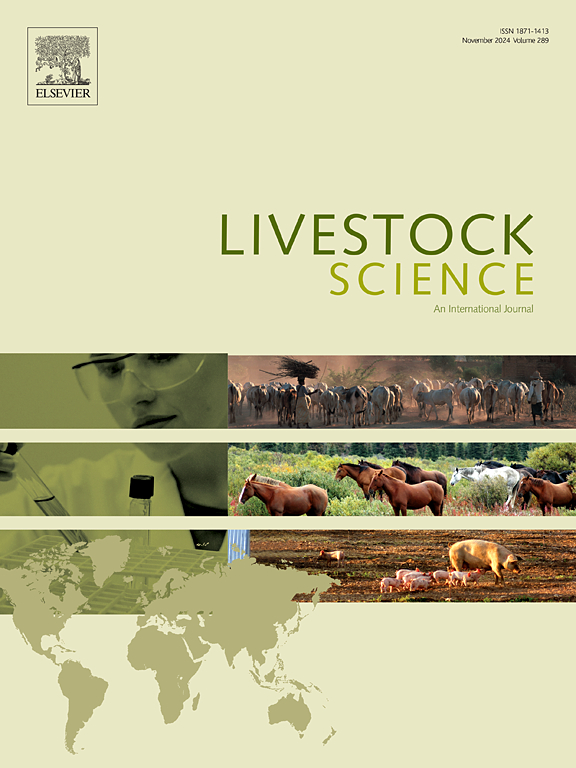Methane mitigation in practically applicable dairy diets: Impact of diet composition and extruded linseed
IF 1.9
3区 农林科学
Q2 AGRICULTURE, DAIRY & ANIMAL SCIENCE
引用次数: 0
Abstract
Recognized strategies to mitigate methane (CH4) emissions from dairy cows include increased levels of dietary starch or lipids. Most studies have tested extreme experimental diets that are rarely applied in practice, as farmers generally apply lower concentrations. In the present study we evaluated the effects of partial replacement of grass silage (GS) with corn silage (CS) and extruded linseed (EL) supplementation in optimized dairy cattle diets under conventional farming conditions. Three 15-week experiments were conducted in three periods: adaptation (3 weeks), pre-treatment (6 weeks), and treatment (6 weeks). A reference group receiving a control diet was compared to each treatment group. In EXP1, GS (65 % GS, 35 % CS) was partially replaced with CS (35 % GS, 65 % CS). In EXP2 and EXP3, EL (13.8 % of dietary DM, fat increased by 1.5 %) was added to a CS-based (EXP2) and to a GS-based diet (EXP3). No significant effect was observed on milk production and CH4 emissions when replacing GS with CS. EL addition to the CS-based diet showed a trend toward a 9 % reduction in CH4 production and yield (p = 0.097 and p = 0.074), while no significant effect of EL was observed for the GS-based diet. In summary, replacing GS with CS had no effect on production or CH4 emissions, while adding EL to a CS-based diet showed potential for CH4 mitigation. This study shows that recognized CH4 mitigation strategies may not prove effective when diets are optimized based on practical guidelines for high-producing dairy cows.
在实际适用的奶牛日粮中减少甲烷:日粮组成和挤压亚麻籽的影响
减少奶牛甲烷(CH4)排放的公认策略包括提高饲粮淀粉或脂质水平。大多数研究都测试了很少在实践中应用的极端实验性饮食,因为农民通常使用浓度较低的饮食。本研究评价了在常规饲养条件下,优化奶牛饲粮中添加玉米青贮(CS)和膨化亚麻籽(EL)部分替代草青贮(GS)的效果。试验分适应期(3周)、预处理期(6周)和处理期(6周)进行。每个治疗组与接受对照饮食的参照组进行比较。在EXP1中,部分用CS (35% GS, 65% CS)代替GS (65% GS, 35% CS)。在EXP2和EXP3组,分别在cs型(EXP2)和gs型(EXP3)饲粮中添加EL(占饲粮DM的13.8%,脂肪增加1.5%)。用CS代替GS对产奶量和CH4排放无显著影响。在cs基础饲粮中添加EL有使CH4产量和产出量降低9%的趋势(p = 0.097和p = 0.074),而在gs基础饲粮中添加EL无显著影响。总之,用CS代替GS对产量或CH4排放没有影响,而在以CS为基础的日粮中添加EL有可能减缓CH4。本研究表明,如果根据高产奶牛的实用指南对日粮进行优化,公认的CH4缓解策略可能并不有效。
本文章由计算机程序翻译,如有差异,请以英文原文为准。
求助全文
约1分钟内获得全文
求助全文
来源期刊

Livestock Science
农林科学-奶制品与动物科学
CiteScore
4.30
自引率
5.60%
发文量
237
审稿时长
3 months
期刊介绍:
Livestock Science promotes the sound development of the livestock sector by publishing original, peer-reviewed research and review articles covering all aspects of this broad field. The journal welcomes submissions on the avant-garde areas of animal genetics, breeding, growth, reproduction, nutrition, physiology, and behaviour in addition to genetic resources, welfare, ethics, health, management and production systems. The high-quality content of this journal reflects the truly international nature of this broad area of research.
 求助内容:
求助内容: 应助结果提醒方式:
应助结果提醒方式:


